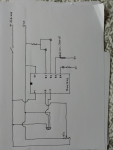Thanks to all for your advice and patience!
I routinely fit a spike suppression diode across any inductive loads but omitted to show it on the diagram - my mistake...
I tried the suggestion of disconnecting all outputs and running the program whilst checking voltage on the pins:
B1,B2 & B4 were fine but B3 was providing only 1.4 vlts and B5 2.4 vlts.
I had tried using a TIP 122 to drive the relay but this was no more successful .....
don't know if it's important but the cross hatched globe in the diagram is a PIR sensor.
I might try driving the relay from one of the 'good' pins - once I've check the current draw of the relay (which is 500 ohms)
Prior to that I'm going to program a new chip and run it without any outputs connected and check if it's my wiring or a duff chip.
I'll let you know - unless it's my incompetence

in which case i'll destroy the evidence and deny all knowledge
thanks again


